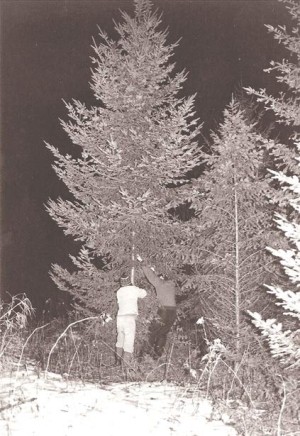Growing up, the tree farm that my family managed for timber and maple syrup production had a Christmas tree component – 10,000 little seedlings, mostly white spruce, balsam fir, and Scots pine, with some blue spruce, Douglas fir, and Fraser fir mixed in for diversity.
We’ve since phased out of the Christmas tree business, and what’s left of the plantation stands as a testament to our advancing age. Today, the little spruce seedlings have become sweeping 35-foot-tall trees. While a human still has to stoop to stand beneath the canopy, animals have no such problem, and the thicket is full of cottontails, ruffed grouse, and the predators that hunt them. The rows of balsam fir have been whittled from a large rectangle into a square by a farmer up the road who makes wreaths from the branch tips. The Scots pine are today an eyesore – all twisted and rusty and largely needle-less, even as they cling to their doomed lives.
I shouldn’t say we’ve completely phased out of the Christmas tree business. My parents do still harvest one tree a year, a seasonal lesson to their children about thrift and marital compromise. A 30-foot tree is toppled and the top cut out of it, which seems like it might render a conical, tree-like form but never does. In a Christmas tree stand, covered in lights and tinsel, the tree top looks like a tree top – more block than cone, more sparse than full. Whereas Charlie Brown’s tree was humble, this one, on account of its massive sprawl, is decidedly not. It IS the elephant in the room. Visitors just smile with their mouths open and don’t really know how to take it. Mom beams proudly. To her, it’s her tree. Something she grew. And she’s cheap (something that sounds harsh in writing but is meant lovingly). “Why on earth would you pay $30 for something you could have for free,” she asks as if it were the simplest question in the world; her eyes the same eyes she had as a scrappy three-year-old in the black and white family photo album. Back then it was her and her single mom against the world.
I smile and say: “Absolutely.”
For his part, dad tries his best to disguise his displeasure. He’s a tree guy, remember, a forester and a former Christmas tree grower. Someone who spent hours and hours coddling baby trees, nourishing them, raising them up to be perfectly full and symmetrical. You can imagine him then, staring at this monstrosity every year with a lemony look – interject your own analogy here: an architect who, out of love, lives in a hovel; an English teacher forced to communicate solely through instant messaging and Twitter; a chef sitting down to a four course Christmas dinner at Burger King.
In any case, he sighs, then gets over it. As the tree goes up he tells us which species he’s chosen this year, and there’s a glimmer in his eyes then. He tells us all about the tree, why it makes a good tree, how it holds its needles or its color or smells better than any other species. And as he tells us these natural history stories, my brothers and I become kids again, all of us listening intently to our tree farmer pop, all of us completely convinced that whatever tree we had did in fact represent peak evolution in the Christmas tree department.
This reminiscence got me thinking about the relative merits of different Christmas tree species, and I want to know what your favorite species is and why. We put the question out to our Facebook friends last week and they got us started. Balsam fir jumped out to an early lead with 8 votes, Fraser fir got 2 votes, and Douglas fir, Meyer spruce, Canaan fir, and good old white pine tallied a vote a piece. Don’t be shy – tell us what you think. If we get enough data we can crown an official Northern Woodlands Christmas tree right in time for the big day.



Discussion *